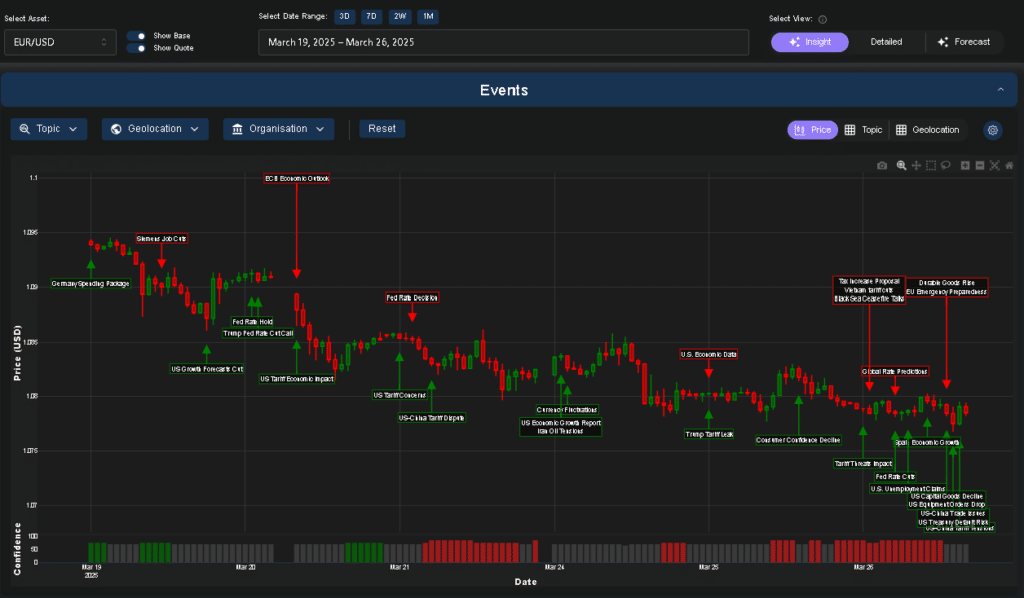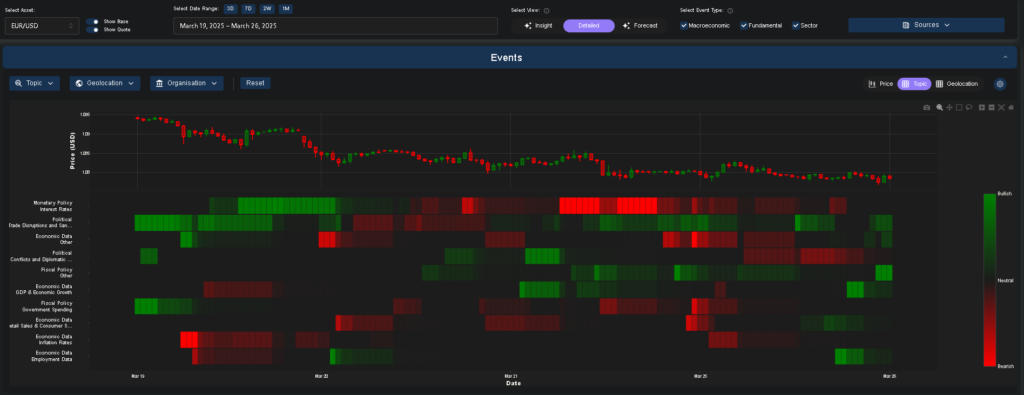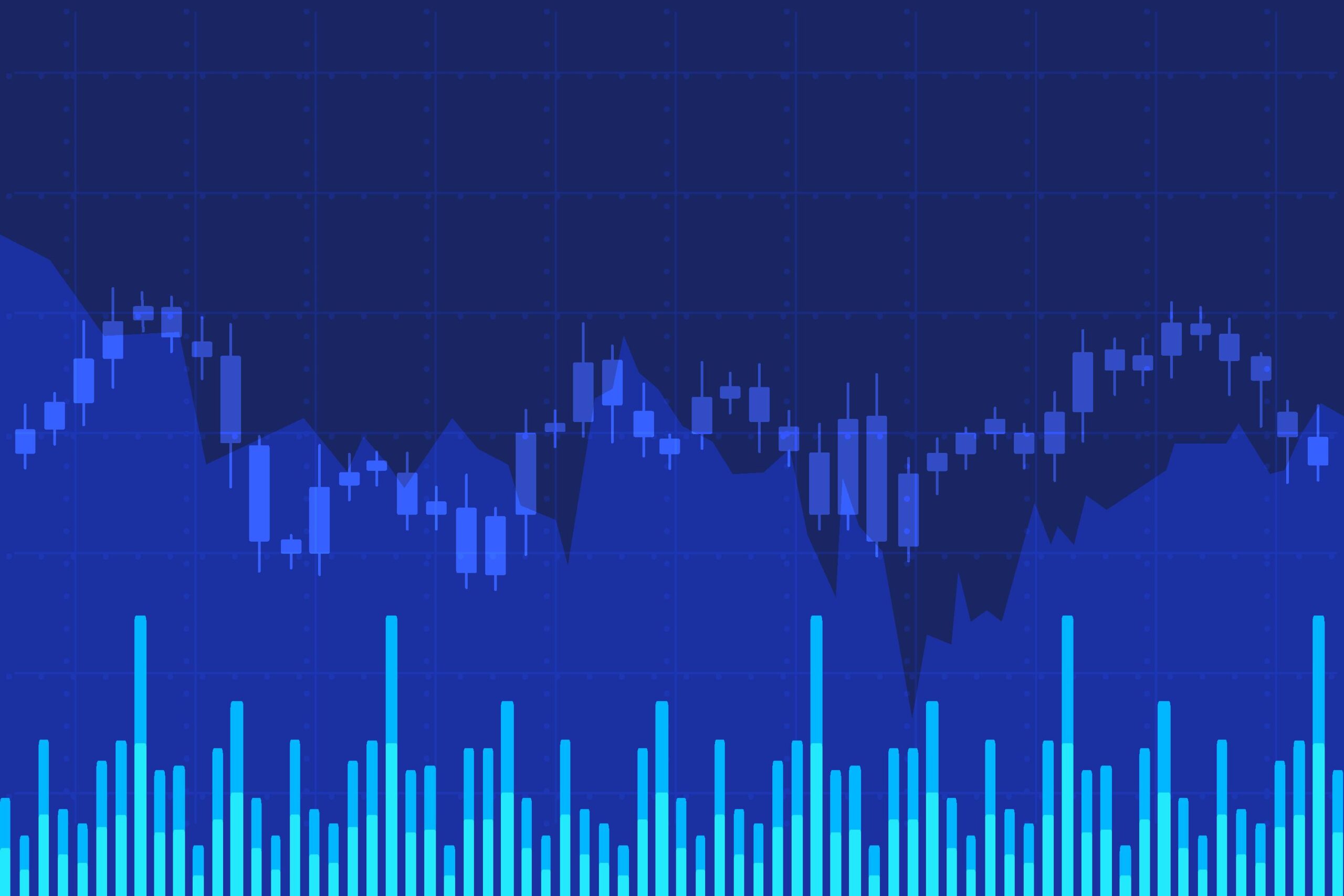*This article provides currency traders, forex investors, and financial analysts with an expert analysis of the current factors influencing EUR/USD price action, including central bank policies, economic indicators, and geopolitical developments, drawing on real-time data from our Trading Co-Pilot platform.
The EUR/USD currency pair, representing the relationship between two of the world’s largest economies, continues to reflect broader macroeconomic developments and shifting market sentiment. In this article, we’ll examine EUR/USD market sentiment at this current point in time, using analysis taken from our Trading Co-Pilot Analyst Insight view, which surfaces several intriguing patterns useful for traders and investors alike.
Recent EUR/USD market sentiment trends
According to our Trading Co-Pilot’s analysis, the EUR/USD pair has demonstrated remarkable stability in recent days, hovering consistently around the 1.08 level despite significant economic releases and geopolitical developments. While such stability might suggest market equilibrium, beneath the surface lies a complex interplay of factors influencing EUR/USD market sentiment.
To begin with, it’s worth noting that the US dollar has shown relative strength compared to recent weeks, supported by robust economic indicators from the United States. Conversely, the stability masks underlying volatility factors. As one central bank moves in one direction, another shifts course in response – creating a delicate balancing act that maintains apparent calm while tensions build underneath.

Above: EURUSD market sentiment around recent market events, taken from Analyst Insight mode of our Trading Co-Pilot
Federal reserve policy and EUR/USD market sentiment
In essence, the Federal Reserve’s recent policy stance has significantly shaped EUR/USD market sentiment. As our Trading Co-Pilot highlights, the price opened at 1.09 but fell to 1.08 as the Federal Reserve opted to keep interest rates unchanged, reflecting a cautious approach amid rising economic uncertainty and ongoing tariff discussions.
Beyond any doubt, this cautious approach by the Fed has buoyed the dollar relative to the euro, driving the pair downward. Taking everything into account, the Fed’s indication that it is not in a hurry to cut interest rates has cemented expectations for higher-for-longer U.S. rates, maintaining dollar support.
Interestingly enough, this comes against a backdrop of deteriorating U.S. consumer confidence, which fell for the fourth consecutive month, reaching a 12-year low. Despite this concerning trend, the dollar has maintained its position, suggesting currency traders are prioritising interest rate differentials over consumer sentiment indicators.
European fiscal developments and EUR dynamics
Looking across to Europe, fiscal developments have introduced a novel element to EUR/USD market sentiment. With remarkable timing, German MPs recently approved what has been termed a fiscal ‘bazooka’ aimed at boosting defence and infrastructure spending. In a manner of speaking, this represents a significant shift in German fiscal policy, traditionally characterised by conservatism.
Notwithstanding this apparently euro-positive development, the currency failed to gain substantial ground against the dollar. From another perspective, this suggests that market participants may be viewing European fiscal expansion with caution, potentially concerned about longer-term debt sustainability or insufficient economic returns on spending.
Over the course of recent trading sessions, the euro has struggled to break above the 1.09 level, repeatedly failing to establish momentum. All things considered, this technical resistance aligns with the fundamental picture of a euro facing headwinds and downward pressure despite supportive policy developments.
Tariff concerns shaping market dynamics
One cannot discuss current EUR/USD market sentiment without addressing the elephant in the room – tariff concerns. As a matter of fact, our Trading Co-Pilot has consistently highlighted this theme across multiple days of analysis, noting that ongoing concerns regarding tariffs continued to affect market sentiment, with analysts warning of potential economic impacts.
In the final analysis, these tariff discussions introduce significant uncertainty into global trade dynamics, with potentially asymmetric impacts on the European and U.S. economies. By all accounts, markets appear to be pricing in greater vulnerability for European exporters, contributing to euro weakness.
Surprisingly enough, President Trump’s calls for lower interest rates due to economic pressures from tariffs have not substantially altered the dollar’s trajectory. For the time being, the market appears to be focusing on the Federal Reserve’s independent stance rather than political pressure for monetary easing.
Economic data influencing sentiment
The role of economic data releases in shaping EUR/USD market sentiment cannot be overstated. In particular, recent U.S. economic data has presented mixed signals – strong headline numbers in some areas contrasting with concerning details in others.
Even so, the overall narrative supports dollar resilience, with growth differentials continuing to favour the U.S. over Europe. In light of this, recent strong economic data from the U.S. contributed to a stronger dollar, impacting currency pairs like EUR/USD.
Above all else, upcoming data releases will be crucial for determining the next directional move in EUR/USD market sentiment. All things considered, surprises in inflation, employment, or growth figures could quickly disrupt the current equilibrium.
Geopolitical factors and risk sentiment
In this context, it’s important to acknowledge how broader geopolitical developments influence EUR/USD market sentiment through their impact on risk appetite. Tensions between the US and Iran have escalated, affecting global oil prices and, by extension, risk sentiment in currency markets.
From this standpoint, the euro typically weakens against the dollar during periods of heightened geopolitical tension, reflecting the dollar’s safe-haven status. Surprisingly enough, recent escalations have not triggered substantial flight to safety, suggesting markets may be becoming desensitized to certain types of geopolitical news.
Under these circumstances, traders should remain alert to escalations that break this pattern of complacency, potentially triggering more significant moves in the EUR/USD pair.

EUR/USD market sentiment – a visual representation of the complex interplay of factors influencing dynamics taken from our Trading Co-Pilot Sentiment Heatmap tool
Navigating EUR/USD in the current climate
To sum up, current EUR/USD market sentiment reflects a complex balance of factors, with dollar strength supported by interest rate differentials but tempered by economic concerns. The euro, meanwhile, struggles to capitalise on supportive fiscal developments amid broader concerns about European economic performance. For all intents and purposes, preparing for increased volatility as key central bank decisions, economic data, and policy developments unfold in the coming weeks would be prudent.
Gain deeper insights into EUR/USD market sentiment
Stay ahead of currency market developments with our AI-powered Trading Co-Pilot. Our platform processes thousands of news sources and markets indicators in real-time, delivering institutional-grade analysis directly to your fingertips. Experience how our advanced sentiment tracking can transform your forex trading decisions by identifying emerging trends before they become obvious to the market. Email our team at enquiries@permutable.ai today to arrange your personalised demonstration or simply fill in the form below to begin your complimentary trial.
